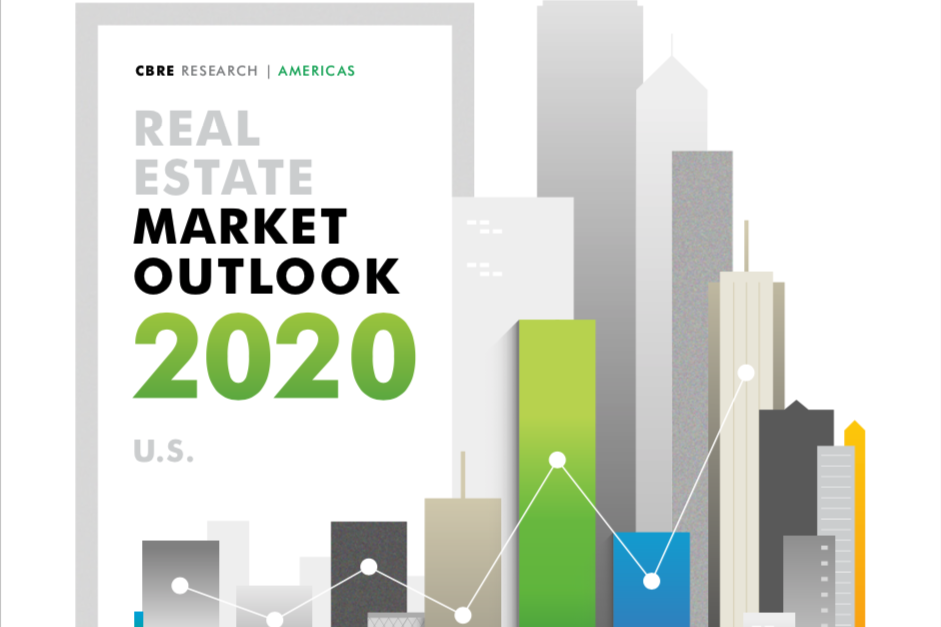The U.S. economy will continue its long expansion in 2020, supporting the solid fundamentals of the commercial real estate market, according to CBRE’s forecast in its 2020 Real Estate Market Outlook report.
CBRE foresees tempered growth in the U.S. commercial real estate market next year due to uncertainty surrounding trade negotiations, weakness in manufacturing and the approach of the presidential election season.
“Next year will bring deceleration on a few fronts, but this still is an expanding economy and a flourishing property market benefiting from a robust job market, solid consumer confidence and low interest rates,” said Richard Barkham, CBRE’s global chief economist and head of Americas Research. “We’ll see resilience across asset classes such as office, retail and multifamily as demand continues to buoy those sectors. And we see transaction volumes and capitalization rates staying relatively stable.”
In Colorado, the commercial real estate markets are anticipated to remain strong in 2020 even after years of significant growth.
“The 2010s ended up being an extraordinary decade for commercial real estate in Colorado. We saw strong leasing volume, increased property values, new capital sources and robust construct pipelines almost universally across all sectors. Although we expect to see some leveling off in certain metrics, it’s important to keep in mind that following several huge years in a row, even tempered rates will indicate a healthy market. Looking ahead, we anticipate demand to persist, driven in part by emerging industries just beginning to make their impact on our state, including e-commerce, cold storage and flexible office space,” said Pete Schippits, senior managing director of CBRE’s Mountain States.
CBRE’s Outlook report includes perspectives on the 2020 trajectories for capital markets and six real estate sectors.
Capital Markets
With global bond yields expected to remain extremely low and equity markets likely more volatile, the stable returns of U.S. commercial real estate will be even more attractive in 2020. Investment volume should reach between $478 billion and $502 billion, on par with the prior two years and making it one of the strongest years on record. Greater investor caution and buyer-seller disconnects on pricing could slightly reduce volume from 2019 levels.
Foreign investment should rebound next year after pullback in 2019, as a substantial decrease in hedging costs for many major investor countries (spurred by falling U.S. interest rates) drives more capital to compete for U.S. assets, particularly in “safe haven” core markets.
Office and Occupier
The growth of office-using jobs will slow to 0.3 percent in 2020 from 1.5 percent between 2018 and 2019. That and other factors will lead to new construction outpacing net absorption of U.S. office space next year, resulting in a slight increase to the national vacancy rate and a slowing of rent growth to a 1.6 percent gain.
CBRE projects the flexible-office sector will grow by 13 percent in 2020, down from an expected 23 percent in 2019. Flex office inventory should grow to 87 million sq. ft. by the end of 2020, accounting for 2.1 percent of the U.S. office market.
Industrial & Logistics
The market’s streak of 38 straight quarters of positive net absorption might be hard to sustain in 2020 with vacancies historically tight. Rents will increase by an average of 5 percent next year. The impact of trade conflicts on the market is expected to be limited.
Retail
CBRE foresees consumers more cautious next year amid uncertainty on several fronts. But rents and net absorption are likely to post small gains due to a relative dearth of new retail construction. Trends likely to gain momentum in 2020 include developers converting malls to mixed-use complexes, Generation Z boosting traffic at retail centers, and health and wellness uses taking more retail space.
Multifamily
Multifamily is positioned for continued favorable performance in 2020 but will experience some cooling due to new supply outpacing demand. New and potential rent control legislation will remain an industry concern. The overall vacancy rate likely will edge up by 20 basis points to 4.5 percent in 2020, still below the long-term average of 5.1 percent. Rent growth will likely edge down to about 2.4 percent, just under the long-term average of 2.6 percent.
Alternatives
Alternative investments – a category including self-storage, data centers, medical offices, life sciences facilities, senior housing and student housing – has grown to a 12.5 percent share of all commercial real estate investment in 2019 from 6 percent in 2007. CBRE sees investment volume in this category matching the $59 billion annual average of the past six years.
Data Centers
New data center capacity in the primary U.S. markets will increase these markets’ total inventory by 17.3 percent this year, increasing competition among providers in certain markets in 2020. The integration of 5G and Edge deployments into data center users’ portfolios in the coming year may result in an uptick in demand in secondary and tertiary data center markets.
To read CBRE’s 2020 Real Estate Market Outlook report, click here.









